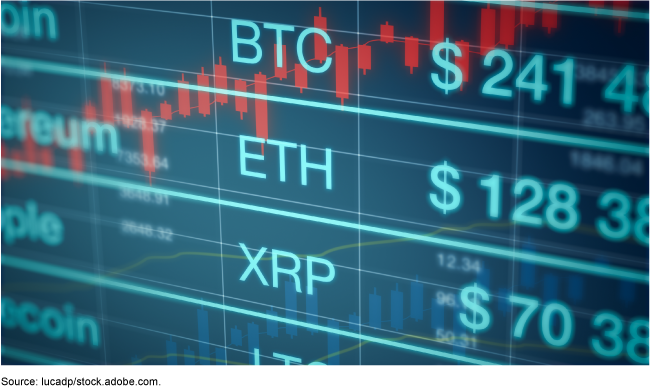Blockchain in Finance: Legislative and Regulatory Actions Are Needed to Ensure Comprehensive Oversight of Crypto Assets

What GAO Found
Blockchain allows users to conduct and record tamper-resistant transactions that multiple parties make without a central authority, such as a bank, when used for financial transactions. Because of these characteristics, blockchain-related products and services have the potential to produce cost savings, faster transactions, and other benefits over their traditional counterparts. However, these benefits have not been fully realized. Furthermore, the significant risks these products pose have been realized and negatively affected consumers and investors. For example, crypto assets have experienced price volatility. Also, the bankruptcy of FTX Trading Ltd., a prominent crypto asset trading platform, led to the discovery that a substantial portion of the platform’s assets might be missing or stolen, according to bankruptcy-related documents.
GAO found gaps in regulatory authority over two blockchain-related products that raise consumer and investor protection and financial stability concerns.
- No federal financial regulator has comprehensive authority to regulate the spot market for crypto assets that are not securities. In contrast, platforms that trade crypto asset securities and operate as exchanges as defined by federal securities laws are subject to registration and regulation as national securities exchanges, unless an exemption applies. Several platforms without federal oversight have experienced fraud and trading manipulation. By providing for more comprehensive oversight of these platforms, Congress could better ensure users’ protection from unfair and manipulative trading practices.
- Gaps in regulatory authority exist in the oversight of stablecoins (a crypto asset purported to hold a stable value relative to a fiat currency, such as the U.S. dollar). To keep their value, issuers often state their stablecoins are backed by reserve assets. But no uniform standards exist for reserve levels and risks or for public disclosure of reserves. This increases the risk that a stablecoin may not be able to hold its value and honor user redemption requests. To the extent these stablecoins become more integrated into the financial system, their failures could pose risks to financial stability. By providing for consistent and comprehensive oversight of stablecoins, Congress could better ensure protections for consumers, investors, and the financial system.
Regulators lack an ongoing coordination mechanism for addressing blockchain risks in a timely manner. For example, regulators identified financial stability risks posed by stablecoins in 2019, but they did not identify the need for Congressional action to address the risks until November 2021 (in a report issued through the President’s Working Group on Financial Markets). A formal coordination mechanism for addressing blockchain-related risks, which could establish processes or time frames for responding to risks, could help federal financial regulators collectively identify risks and develop timely and appropriate responses. In turn, this could improve protections for consumers and investors, mitigate illicit finance and threats to financial stability, and promote responsible innovation and U.S. competitiveness.
Why GAO Did This Study
Blockchain-related financial products and services have grown substantially in recent years. For example, crypto assets reached a peak market capitalization of nearly $3 trillion in November 2021. However, recent volatility, bankruptcies, and instances of fraud in these markets illustrate the harm consumers and investors may face without adequate protections. Regulators and industry stakeholders are concerned regulatory gaps may limit regulators’ ability to address risks these products and services pose. Modernizing the financial regulatory system is on GAO’s high-risk list, partly because some entities are not subject to comprehensive regulation.
GAO was asked to study the regulation of blockchain-related financial products and services. Among other objectives, this report examines regulatory gaps and coordination in regulating these applications. GAO reviewed and analyzed government and industry reports, government guidance and speeches, and laws and regulations. GAO interviewed agency officials and market participants and observers.






